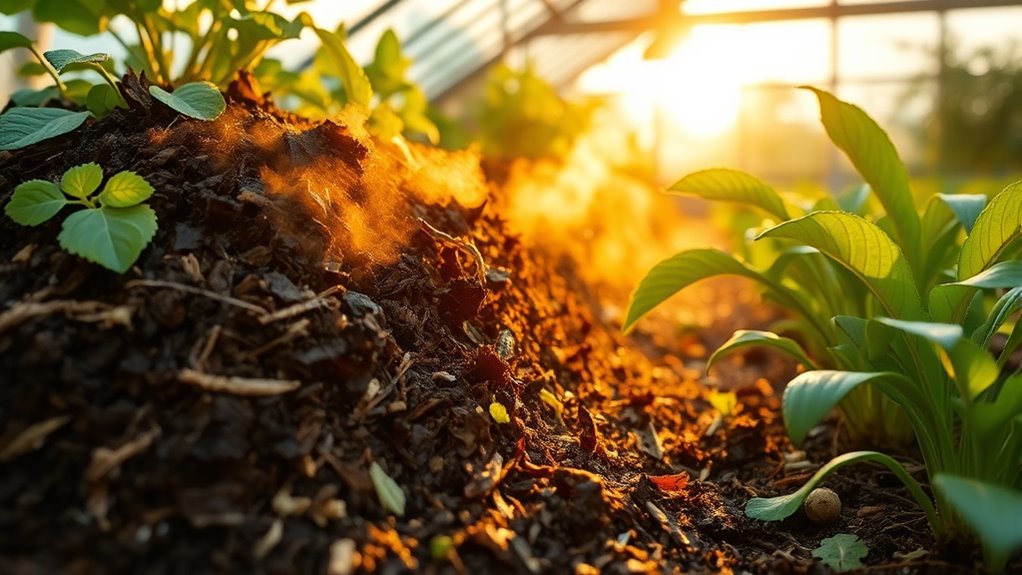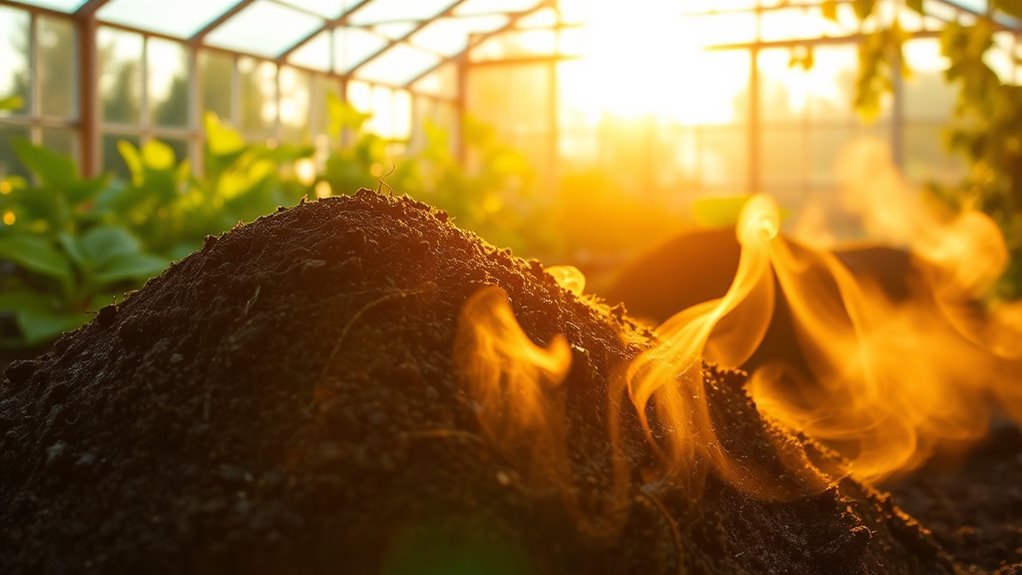You can use compost to heat your greenhouse by managing a well-insulated pile with microbial activity that generates heat naturally. Keep the pile moist, insulated with straw or blankets, and place it in a sheltered, sunny spot or near the greenhouse for better heat transfer. Regularly monitor temperature and turn the compost to maintain microbial activity and prevent overheating. Continued efforts will maximize your compost’s warmth and sustainability. Learn more about optimizing your compost heating system here.
Key Takeaways
- Maintain compost temperatures between 130°F and 160°F to generate consistent heat for your greenhouse.
- Insulate and wrap the compost pile to minimize heat loss and prolong microbial activity.
- Position compost in sheltered, sunlit areas near the greenhouse for efficient heat transfer.
- Regularly monitor temperature and turn the pile to sustain microbial activity and prevent overheating.
- Use larger, well-managed compost piles for sustained heat production and eco-friendly greenhouse warming.

Heating with compost offers an eco-friendly way to warm your home or outdoor spaces by harnessing the natural heat generated during composting. When you understand how compost temperature and heat retention work, you can effectively use compost as a sustainable heating source. Compost piles generate heat through microbial activity, which causes the organic matter to break down. The key is maintaining a high enough compost temperature, typically between 130°F and 160°F, to produce consistent warmth. If your pile stays within this range, it will generate enough heat to be useful for warming a greenhouse or other outdoor structures.
To maximize heat retention, you need to carefully manage your compost. Proper insulation is essential; wrapping your pile with straw, hay, or insulating blankets helps retain the heat produced inside. The more heat your compost retains, the longer it can serve as a source of warmth. Adequate moisture levels and turning the pile regularly also play significant roles. Moisture helps microbes stay active, while turning introduces oxygen, which boosts microbial activity and maintains high compost temperature levels. With consistent management, your compost can sustain elevated temperatures for days or even weeks, providing a reliable heat source.
You should also consider the size and location of your compost pile. Larger piles tend to retain heat better because they have more mass to hold warmth. Positioning your compost in a sheltered, sunlit area minimizes heat loss from wind and cold temperatures. If you’re using compost to heat a greenhouse, placing the pile close to the structure allows heat to radiate inward more efficiently. Additionally, designing a compost bin or enclosure that minimizes heat escape enhances the overall heat retention. A well-insulated system keeps the microbial heat inside longer, ensuring a steady temperature that can warm your greenhouse during colder months. Incorporating regulatory compliance into your setup can also ensure your composting methods meet local environmental standards.
Monitoring compost temperature is indispensable to optimize heat production. Using a compost thermometer, you can track the internal temperature and adjust your management practices accordingly. If temperatures drop below the ideal range, turning the pile or adding more nitrogen-rich materials can help boost microbial activity. Conversely, if the compost gets too hot, turning it can prevent overheating and microbial death, which would decrease heat output. When managed correctly, compost heating can be an efficient, natural alternative to traditional heating systems, helping you reduce energy consumption while supporting your eco-conscious lifestyle.
Frequently Asked Questions
How Much Initial Setup Is Required for Compost Heating Systems?
The initial investment for a compost heating system varies based on size and complexity. Generally, you’ll need to allocate funds for compost bins, insulation, and temperature controls. The setup complexity depends on your experience and system design, but straightforward setups require minimal effort, while larger or more automated systems may need more planning and installation time. Overall, expect some upfront work and costs to make certain of efficient and eco-friendly warmth for your greenhouse.
Can Compost Heating Be Combined With Traditional Greenhouse Heating Methods?
Yes, you can definitely combine compost heating with traditional greenhouse heating methods. This creates a hybrid system that boosts energy efficiency by reducing reliance on fossil fuels. By integrating compost heating, you’ll benefit from eco-friendly warmth while maintaining consistent temperature control. It’s a smart way to optimize your greenhouse’s energy use, lower costs, and support sustainability—all while keeping your plants comfortable year-round.
What Is the Average Temperature Increase Achievable With Compost Heat?
When you ask about the average temperature increase with compost heat, you should consider temperature regulation and compost pile dynamics. Typically, a well-managed compost pile can raise temperatures by 130°F to 160°F (55°C to 70°C), providing consistent warmth. This heat is most effective during the active composting phase, but fluctuations occur based on moisture, aeration, and pile size, so monitoring is key for reliable greenhouse heating.
How Often Should Compost Be Turned or Maintained for Optimal Heat Output?
To maintain ideal heat output, you should turn your compost every 3 to 7 days, depending on compost moisture and aeration frequency. Regular turning ensures proper aeration, preventing compaction and encouraging microbial activity. Keep the moisture level consistent—neither too dry nor too wet—to sustain heat. Monitoring these factors helps your compost generate steady warmth, providing eco-friendly heat for your greenhouse efficiently.
Are There Specific Compost Materials Best Suited for Heating Purposes?
Think of a well-tended fire; your compost should be just as carefully selected. You’ll want materials with high compost nutrient content, like fresh plant matter and manure, to generate steady heat. Keep your compost moisture levels balanced—like a damp sponge—not too dry or soggy. Avoid woody, dense materials that slow decomposition. By choosing the right materials, you’ll create a consistent, eco-friendly warmth for your greenhouse, much like a cozy hearth.
Conclusion
Using compost to heat your greenhouse is a sustainable choice that nurtures your plants and the planet alike. While it offers eco-friendly warmth, it also requires patience and careful management—reminding you that true growth takes time. Embrace this natural method, knowing it’s a gentle, ongoing process that balances environmental responsibility with your gardening ambitions. In this way, compost heating becomes more than warmth; it’s a mindful act of nurturing both nature and your greenhouse’s future.









